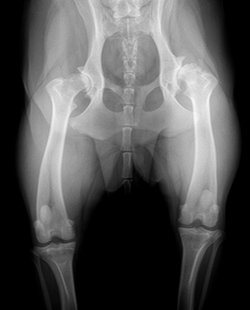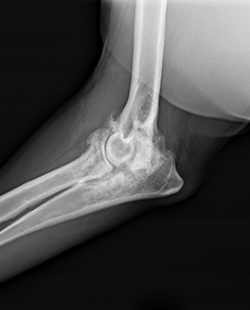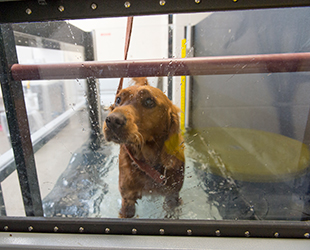About osteoarthritis
Overview
Osteoarthritis can affect dogs and cats – as well as all other pets – of all ages and sizes/breeds. Other terms used for osteoarthritis are simply “arthritis” or “degenerative joint disease.”
Similarly to people, osteoarthritis in dogs and cats can be very painful and severely limit your pet’s quality of life. Common symptoms associated with osteoarthritis include lameness, being less active, and less interest in playing/hiking/walks. There is no cure for osteoarthritis and reversing the disease process is unfortunately not possible at this point (neither in pets nor in people). The best treatment for arthritis is prevention, and understanding osteoarthritis is important even if your pet may not have significant arthritis at this point.
Diagnosis
Diagnosis of osteoarthritis in dogs and cats is generally straightforward and performed by either taking radiographs (X-rays) or observing cartilage changes in the joint during surgery. X-rays are also a good tool to monitor for progression of arthritis and we recommend performing these annually of each joint affected if possible.
The cornerstones of osteoarthritis management

- Weight management/control/maintenance
- Regular, moderate, controlled physical activity and veterinary rehabilitation/physical therapy/conditioning
- Commonly used joint supplements/neutraceuticals
- Pain medications (such as tramadol, NSAIDs [non-steroidal anti-inflammatory drugs], etc.)
- Alternative treatment options such as laser treatment, joint injections, shockwave treatment, stem cell therapy, and surgical treatment options etc.
Osteoarthritis affects the patient as a whole, so the whole patient needs treatment. Treatment needs to focus not only on the cartilage (which is the main problem) but also on the surrounding structures that are equally affected (such as joint capsule, ligaments surrounding muscles, and the pain associated with osteoarthritis). Effective management hinges on a careful balance of activity, nutrition, muscle development, weight management, medications, and joint supplements. In many cases, various treatment modifications (changing medications/trying different types of medications, etc.) are necessary. Management must be comprehensive and sustained, and it is important to remember that regular follow up is necessary, not only to gauge the success of therapy, but to re-evaluate and add in other therapies as indicated by the specific needs of your pet.
Weight management

Attaining and maintaining a lean body conformation through proper nutrition and feeding practices is the most important cornerstone of effective osteoarthritis management and prevention. It has been shown that skinny dogs have less arthritis and a longer life expectancy! This has been investigated in a life-long study where dogs were grouped into those that were fed as much as they wanted or restricted feeding (which were the ones that lived longer and had less arthritis). 25 percent restriction of food intake increased median lifespan by 15 percent (an average of two years), and delayed the onset of osteoarthritis and other degenerative diseases. To accurately judge a dog’s weight we use the Nestle PURINA Body Condition Scoring.
A study also confirmed the effectiveness of weight reduction on decreasing the lameness associated with osteoarthritis. Maintaining a lean body conformation through restricted feeding may not prevent osteoarthritis, but it goes a long way toward delaying it and minimizing the symptoms associated with it.
Exercise modification/physical rehabilitation
Regular physical activity is paramount to the treatment of osteoarthritis both in humans and animals. A lifestyle of regular activity that is moderated away from intermittent extremes of exercise (such as long hikes on the weekends) and activities to which the pet is not conditioned is essential. Ideally, multiple shorter walks are better than one long one. The same activity every day (or slightly increasing if tolerated) is ideal. Prior to high-impact activities (such as chasing ball, playing with other dogs) a “warm-up” period of walking is ideal. We believe in and have seen the benefits of therapeutic exercise and physical rehabilitation on pets with osteoarthritis.

Therapeutic exercise with a certified small animal physical rehabilitation practitioner is a key step to converting the osteoarthritic, overweight, and sedentary pet to a lean, physically fit pet who is enthusiastic about activity again. Traditional rehabilitation in pets has included activities such as passive stretching and range of motion exercises, controlled walking through or around obstacles such as tall grass and pools, swimming, and underwater treadmills. We have seen osteoarthritic dogs who were overweight and out of shape quickly begin to lose weight and gain cardiovascular fitness when enrolled in a therapeutic exercise and physical rehabilitation program. We tend to advocate supervised programs at the beginning to make sure treatment is effective, but also provide home exercise programs. Generally, a patient assessment is performed upon entry into the program. This includes body weight, body condition score, joint range of motion measurements, limb circumference, etc. We then establish therapeutic goals that you have for your pet. Some objective therapy goals may include appropriate body weight and body condition, desired length of comfortable daily walk, ability to climb stairs again, etc. Some subjective therapy goals may include increased enthusiasm for exercise, more energy, etc. After a few weeks of therapy, our patients generally begin to show signs of enthusiasm toward leash walks and improved energy levels and we will adjust the rehabilitation protocol weekly as needed.
Commonly used joint supplements/nutraceuticals
Nutraceuticals are dietary supplements that are not strictly supervised by the FDA like pharmaceuticals. They function as building blocks to some of the normal constituents of joint cartilage and they decrease the effect of some of the destructive enzymes present within an osteoarthritic joint. They also enhance the lubricating effect of the joint fluid. They ideally should be used early in the course of osteoarthritis and with the aim of slowing down arthritis progression rather than accomplishing a dramatic decrease in clinical symptoms (if present). It is unclear whether they have any role in prevention, but due to the lack of significant side effects we recommend supplementation even after routine procedures that may result in osteoarthritis. Again, one should not expect to see a quick or dramatic response to nutraceuticals. Rather, it takes several weeks to obtain therapeutic levels in joint cartilage and joint fluid, and this is reflected in the delayed onset of their beneficial effects.
Omega-3 fatty acids
Omega-3 fatty acids have been shown to decrease inflammation present within arthritic joints. In dogs, the specific fatty acid, EPA, has been shown to have the most effect in contrast to humans and horses (i.e. flaxseed oil is not effective in pets). Salmon oil and commercially available joint diets all have EPA (and DHA) as the predominant omega-3 fatty acid. Evidence-based medicine suggests that fish oil is more effective than Glucosamine products at alleviating symptoms associated with arthritis, so we suggest supplementing your dog’s food with fish oil capsules or feeding a joint diet.
Glucosamine/Chondroitin Sulfate containing agents
It is important to realize that nutraceuticals are classified as dietary supplements by the FDA, and are not subject to the same stringent regulatory guidelines as pharmaceuticals (prescription drugs). In fact, several studies have shown that as many as 84% of the human over-the-counter nutraceutical products vary widely in their composition and fail to meet their label claims. Further, this study showed that less expensive products tended to deviate more widely from label claims. This leaves the consumer in a difficult place regarding determining product value.
Glucosamine/Chondroitin sulfate containing agents that have research indicating beneficial effects are Cosequin®, Dasuquin®, and Glycoflex III®. Dasuquin combines the glucosamine and chondroitin sulfate ingredients with avocado-soya unsaponifiables. Unsaponifiables decrease inflammation and, in human osteoarthritis trials, decreases pain scores and reliance on anti-inflammatory drugs.
Polysulfated Glycosaminoglycans (PSGAGs, Adequan) and Polyglycan SA
This drug group was originally designed to treat acute joint cartilage injuries, but has been approved for use in dogs for arthritis. Not only may PSGAGs help repair damaged cartilage, but they can interfere with destructive painful pathways in the joint. PSGAGs can also be effective in cats. The PSGAGs are naturally occurring in joints. A series of injections, twice weekly for four weeks to start, is implemented to determine if a patient responds well. If a patient has a significant beneficial response, a plan is implemented to continue the injections. The PSGAG product used at CSU is called Adequan. We also similarly use a product called Polyglycan SA, which has been investigated at CSU. This product contains hyaluronic acid, glucosamine and chondroitin – the building blocks for one of the major molecules in cartilage.
Pain medications
Pain medications are commonly used to treat arthritis. However, it is important to realize that none of these are without side effects that can potentially be very serious. Therefore, it is important to use pain medications only at the recommended dose and only if the above measurements are shown to be insufficient.
Non-steroidal Anti-Inflammatory Drugs (NSAIDs)
Non-steroidal anti-inflammatory drugs are a cornerstone in the treatment of osteoarthritis in dogs and cats. These medications are very effective and act by blocking inflammatory pathways that lead to the production of destructive molecules (prostaglandins) and subsequent pain. Many studies have documented the usefulness of these medications. NSAIDs do not appear to significantly alter the progression of osteoarthritis. As with any medication, adverse side effects can occur, specifically in the gastrointestinal, liver, and kidney systems. We recommend patients be observed for diarrhea, vomiting, melena (dark, tarry stool), lethargy, and lack of appetite. If any of these are noted, the medication should be discontinued and your veterinarian should be notified immediately. Often, we will advise blood tests be performed prior to NSAID therapy and periodically throughout treatment. Additionally, the use of these medications in conjunction with other types of NSAIDS (e.g. aspirin, ibuprofen) or corticosteroids can lead to serious illness and should be avoided completely.
Others
Tramadol is a drug we use frequently in addition to NSAIDs because it has very little severe side effects. Tramadol is a synthetic opioid that does not share the common side effects of most natural opioids. Tramadol can be used separately or in combination with non-steroidal anti-inflammatory drugs and can also be used in cats. Side effects are considered rare but may include constipation, and mild sedation or bizarre behavior (if noted, the dose should be reduced). Other drugs we may consider for your pet include gabapentin (which is especially useful for pain originating from neurological disease), amantadine, and others.
Surgery and Alternative Treatment Options
Surgery
Sometimes effective management of osteoarthritis in dogs and cats involves surgery. Surgery may involve joint stabilization in the event of pathologic instability (ex: tibial plateau leveling osteotomy for treatment of a ruptured cranial cruciate ligament), or removal of cartilage/bony chips (arthroscopic surgery), or joint replacement with a prosthetic joint (ex: total hip replacement). Another option, especially for the hock and wrist, is fusion of the joint (arthrodesis), because this eliminates the pain associated with arthritis. For the hip joint we can also remove parts of the joint (called a femoral head and neck ostectomy). The relative importance and timing of surgery is variable depending upon the injury or condition underlying the osteoarthritis.
Alternative Treatment Options
If the above treatment options do not result in satisfactory results, we may consider further options such as adjunctive pain medications, joint injections (such as hyaluronic acid, steroids, platelet rich plasma [PRP], stem cells) or alternative treatments such as low level laser therapy, shockwave therapy, acupuncture, etc.